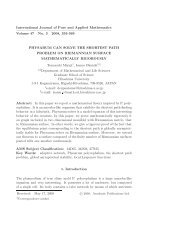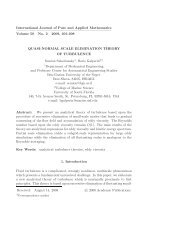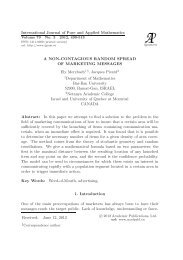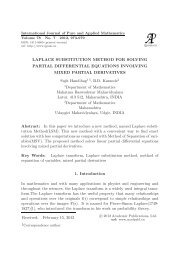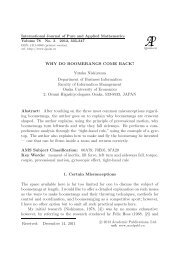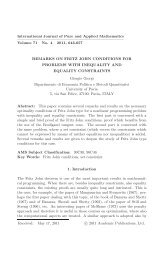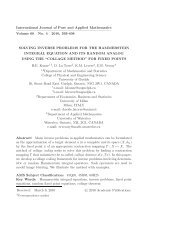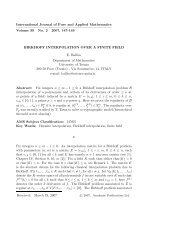FINDING N-TH ROOTS IN NILPOTENT GROUPS AND ...
FINDING N-TH ROOTS IN NILPOTENT GROUPS AND ...
FINDING N-TH ROOTS IN NILPOTENT GROUPS AND ...
You also want an ePaper? Increase the reach of your titles
YUMPU automatically turns print PDFs into web optimized ePapers that Google loves.
576 S. Sze, D. Kahrobaei, R. Dambreville, M. Dupas<br />
Definition 3.2. A subgroup A of an R−group G is said to be an isolated<br />
subgroup if for every element a ∈ A and every n ∈ N the solution to x n = a, if<br />
it exists, is an element in A.<br />
Definition 3.3. Let M be a set of elements of an R−group G. The<br />
isolated closure, or isolator of M in G, denoted I(M), is the unique minimal<br />
isolated subgroup of G containing M.<br />
A normal subgroup N of an R−group G is isolated if and only if the factor<br />
group G/N is torsion-free.<br />
Proposition 3.4. If H is an isolated subgroup of an R−group G and<br />
if G/H is an R−group (note that this isn’t always true), then in the natural<br />
one-to-one correspondence between all subgroups of G/H and all subgroups of<br />
G containing H, isolated subgroups correspond to each other. In other words,<br />
isolated subgroups of G/H correspond to isolated subgroups of G containing<br />
H.<br />
Proof. Suppose that A/H is an isolated subgroup of G/H and we have<br />
g n = a for g ∈ G and a ∈ A. We want to show that g ∈ A. Since g n = a and<br />
A/H is an isolated subgroup of G/H, then (gH) n = aH implies that gH ∈ A/H<br />
so that g ∈ A.<br />
Now suppose that A is an isolated subgroup of G containing H and that<br />
(gH) n = aH for g ∈ G and a ∈ A. This implies that g n = ah ∈ A. Since A is<br />
isolated, this means that g ∈ A so gH is an element of A/H, hence isolated.<br />
Proposition 3.5. The centralizer of an arbitrary set of elements of an<br />
R−group G is an isolated subgroup.<br />
Proof. Let M be an arbitrary set of elements of G. Let x an element of G<br />
such that x n is an element of the centralizer of M. Then a −1 x n a = x n for all<br />
a ∈ M implies that (a −1 xa) n = x n . Since G is an R−group, this means that<br />
a −1 xa = x, so x ∈ CG(M) as well.<br />
It follows that the center of an R−group is isolated.<br />
Proposition 3.6. In every R−group G, the equation a k b ℓ = b ℓ a k , where<br />
a, b ∈ G, implies that ab = ba.<br />
Proof. It suffices to prove this proposition when one of k or ℓ is 1. Without<br />
loss of generality, we assume that ℓ = 1 so that we have a k b = ba k and we<br />
want to show that this implies ab = ba for a and b in an R−group G. Now,<br />
(b −1 ab) k = b −1 a k b = b −1 ba k = a k . Since G is an R−group, this implies that<br />
b −1 ab = a.



